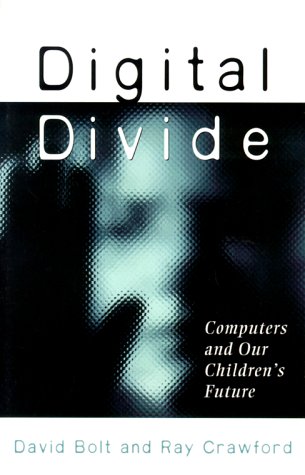Digital Divide - Hardcover

"synopsis" may belong to another edition of this title.
In Digital Divide: Computers and Our Children's Future, David Bolt and Ray Crawford are quick to point out that a presidential promise to wire every school does little to address the real issue. Mere access is not enough. If you're going to give schools computers, you also need to provide them with ongoing technical support, upgrades and - the toughest part - training for teachers, not only in how to use the computers, but also in how to usefully integrate the technology into a meaningful curriculum.
Digital Divide was written as a partner to a television series that Bolt created and produced for PBS in 1997. The book is at its strongest in documenting the reality of the divide with clear statistics and compelling stories. The poorer school districts, where minorities are usually the majority, don't have the access to technology that the wealthier districts have. Nor, for a host of reasons, is in-home technology as readily available. And in coed classrooms at all socioeconomic levels, girls are deferring to boys in seeking out and exploring new technology.
The authors offer theories as to the origins of these phenomena, but where specific solutions are craved, few are given. A fundamental discussion focuses around how to use the promised onslaught of computers in the schools. Will there be one computer per school? Class? Student? Do we integrate the computers with the current curricula so they become an enhancement of the pencil and paper and an annex to the library, or do we use them to train students in the tools of the technology trade, foregoing traditional education in the humanities? Both of these approaches require immense resources and an overhaul of the American education system, and neither the resources nor the overhaul appears to be in the picture for many years to come.
Bolt and Crawford provide a glimmer of hope by highlighting organizations (mostly nonprofit) that are aggressively addressing the divide. For poor neighborhoods, there are organizations like Plugged In, an East Palo Alto, Calif., computer resource center that offers an after-school program, as well as computer access and training for older students and adults - if they agree to use their new skills to give back to the community. And in an attempt to close the technogender gap, there's SmartGrrls, which provides educational content for girls in math and science and introduces female role models in technology.
Along with detailed statistics about the people on both sides of the gap, Digital Divide concludes by providing a list of resources, including organizations and a small group of experts devoted to researching and bridging the divide. While the list is in no way comprehensive, it's a useful starting point for anyone interested in learning more about the divide and how some organizations address the issue. It also underscores the authors' case that truly bridging the digital divide is an extensive long-term project dependent on the dedication of people on every side of it. -- From The Industry Standard
"About this title" may belong to another edition of this title.
- PublisherTV Books
- Publication date2000
- ISBN 10 1575000865
- ISBN 13 9781575000862
- BindingHardcover
- Edition number1
- Number of pages208
- Rating
Buy New
Learn more about this copy
Shipping:
FREE
Within U.S.A.
Top Search Results from the AbeBooks Marketplace
Digital Divide
Book Description Hardcover. Condition: New. Seller Inventory # Abebooks375626

